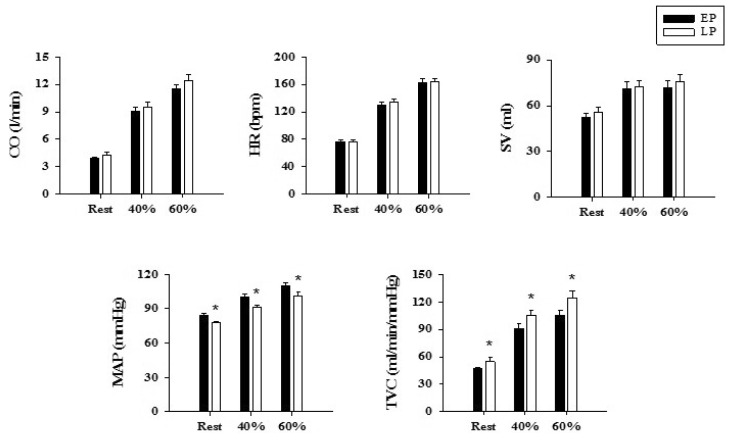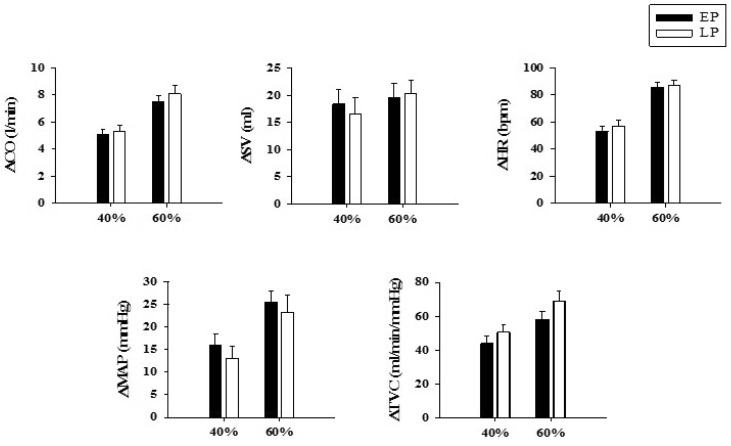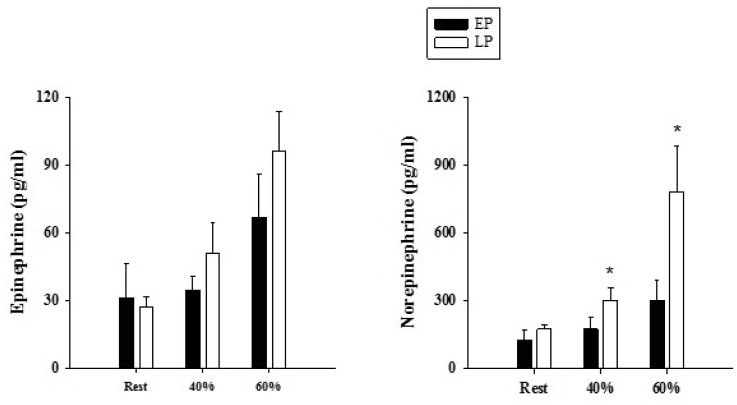Korean J Physiol Pharmacol.
2013 Dec;17(6):499-503. 10.4196/kjpp.2013.17.6.499.
Effects of Ovarian Cycle on Hemodynamic Responses during Dynamic Exercise in Sedentary Women
- Affiliations
-
- 1Graduate School of Physical Education, Kyung Hee University, Yongin 446-701, Korea. kyung19692002@khu.ac.kr
- 2Department of Internal Medicine, University of California at Davis, Califonia 95616, USA.
- KMID: 2285476
- DOI: http://doi.org/10.4196/kjpp.2013.17.6.499
Abstract
- This study tested the hypothesis that effects of the menstrual cycle on resting blood pressure carry over to dynamic exercise. Eleven healthy females were studied during the early (EP; low estrogen, low progesterone) and late follicular (LP; high estrogen, low progesterone) menstrual phases. Stroke volume (SV), heart rate (HR), cardiac output (CO), systolic blood pressure (SBP), diastolic blood pressure (DBP), and total vascular conductance (TVC) were assessed at rest and in response to mild and moderate cycling exercise during EP and LP. During EP, compared to LP, baseline SBP (111+/-1 vs. 103+/-2 mmHg), DBP (71+/-2 vs. 65+/-2 mmHg) and mean arterial pressure (MAP) (84+/-2 vs. 78+/-1 mmHg) were higher and TVC (47.0+/-1.5 vs. 54.9+/-4.2 ml/min/mmHg) was lower (p<0.05). During exercise, absolute values of SBP (Mild: 142+/-4 vs. 127+/-5 mmHg; Moderate: 157+/-4 vs. 144+/-5 mmHg) and MAP (Mild: 100+/-3 vs. 91+/-3 mmHg; Moderate: 110+/-3 vs. 101+/-3 mmHg) were also higher, while TVC was lower (Mild: 90.9+/-5.1 vs. 105.4+/-5.2 ml/min/mmHg; Moderate: 105.4+/-5.3 vs. 123.9+/-8.1 ml/min/mmHg) during EP (p<0.05). However, exercise-induced increases in SBP, MAP and TVC at both work intensities were similar between the two menstrual phases, even though norepinephrine concentrations were higher during LP. Results indicate that blood pressure during dynamic exercise fluctuates during the menstrual cycle. It is higher during EP than LP and appears to be due to additive effects of simultaneous increases in baseline blood pressure and reductions in baseline TVC.
MeSH Terms
Figure
Reference
-
1. Adkisson EJ, Casey DP, Beck DT, Gurovich AN, Martin JS, Braith RW. Central, peripheral and resistance arterial reactivity: fluctuates during the phases of the menstrual cycle. Exp Biol Med (Maywood). 2010; 235:111–118. PMID: 20404025.
Article2. Dunne FP, Barry DG, Ferriss JB, Grealy G, Murphy D. Changes in blood pressure during the normal menstrual cycle. Clin Sci (Lond). 1991; 81:515–518. PMID: 1657498.
Article3. Kavitha C, Jamuna BL, Vijayakumar GS. Pressor response during normal menstrual cycle. Int J Biol Med Res. 2012; 3:1975–1981.4. Kelleher C, Joyce C, Kelly G, Ferriss JB. Blood pressure alters during the normal menstrual cycle. Br J Obstet Gynaecol. 1986; 93:523–526. PMID: 3707887.
Article5. Williams MR, Westerman RA, Kingwell BA, Paige J, Blombery PA, Sudhir K, Komesaroff PA. Variations in endothelial function and arterial compliance during the menstrual cycle. J Clin Endocrinol Metab. 2001; 86:5389–5395. PMID: 11701712.
Article6. Schmitt PM, Kaufman MP. Estrogen attenuates the exercise pressor reflex in female cats. J Appl Physiol (1985). 2003; 95:1418–1424. PMID: 12819220.
Article7. Fadel PJ, Wang Z, Watanabe H, Arbique D, Vongpatanasin W, Thomas GD. Augmented sympathetic vasoconstriction in exercising forearms of postmenopausal women is reversed by oestrogen therapy. J Physiol. 2004; 561:893–901. PMID: 15498809.
Article8. Kaplan V, Bucklar GB, Bloch KE. Noninvasive monitoring of cardiac output during exercise by inductance cardiography. Med Sci Sports Exerc. 2003; 35:747–752. PMID: 12750583.
Article9. Hietanen E. Cardiovascular responses to static exercise. Scand J Work Environ Health. 1984; 10:397–402. PMID: 6535242.
Article10. Kaufman MA, Forster HV. Reflexes controlling circulatory, ventilatory, and airway responses to exercise. Handbook of physiology Sect. 12. Exercise: regulation and integration of multiple systems. Bethesda: 1996.11. Swift DL, Earnest CP, Katzmarzyk PT, Rankinen T, Blair SN, Church TS. The effect of different doses of aerobic exercise training on exercise blood pressure in overweight and obese postmenopausal women. Menopause. 2012; 19:503–509. PMID: 22547251.
Article12. Lewandowski J, Pruszczyk P, Elaffi M, Chodakowska J, Wocial B, Switalska H, Januszewicz W, Zukowska-Grojec Z. Blood pressure, plasma NPY and catecholamines during physical exercise in relation to menstrual cycle, ovariectomy, and estrogen replacement. Regul Pept. 1998; 75-76:239–245. PMID: 9802415.
Article13. Hartwich D, Aldred S, Fisher JP. Influence of menstrual cycle phase on muscle metaboreflex control of cardiac baroreflex sensitivity, heart rate and blood pressure in humans. Exp Physiol. 2013; 98:220–232. PMID: 22613743.
Article14. Kim A, Deo SH, Fisher JP, Fadel PJ. Effect of sex and ovarian hormones on carotid baroreflex resetting and function during dynamic exercise in humans. J Appl Physiol (1985). 2012; 112:1361–1371. PMID: 22267388.
Article15. Ettinger SM, Silber DH, Gray KS, Smith MB, Yang QX, Kunselman AR, Sinoway LI. Effects of the ovarian cycle on sympathetic neural outflow during static exercise. J Appl Physiol (1985). 1998; 85:2075–2081. PMID: 9843528.16. Boron WF, Boulpaep EL. Medical physiology: a cellular and molecular approach. Philadelphia: Elsevier Saunders;2005.17. English JL, Jacobs LO, Green G, Andrews TC. Effect of the menstrual cycle on endothelium-dependent vasodilation of the brachial artery in normal young women. Am J Cardiol. 1998; 82:256–258. PMID: 9678305.18. Richard R, Lonsdorfer-Wolf E, Charloux A, Doutreleau S, Buchheit M, Oswald-Mammosser M, Lampert E, Mettauer B, Geny B, Lonsdorfer J. Non-invasive cardiac output evaluation during a maximal progressive exercise test, using a new impedance cardiograph device. Eur J Appl Physiol. 2001; 85:202–207. PMID: 11560071.
Article19. Tordi N, Mourot L, Matusheski B, Hughson RL. Measurements of cardiac output during constant exercises: comparison of two non-invasive techniques. Int J Sports Med. 2004; 25:145–149. PMID: 14986199.
Article20. Bougault V, Lonsdorfer-Wolf E, Charloux A, Richard R, Geny B, Oswald-Mammosser M. Does thoracic bioimpedance accurately determine cardiac output in COPD patients during maximal or intermittent exercise? Chest. 2005; 127:1122–1131. PMID: 15821184.
Article21. Choi OH, Lee SH, Kim EJ, Kim KH, Rhim BY. Expression of nitric oxide synthase and endothelin-1 in human uterine artery from full-term pregnancies. Korean J Physiol Pharmacol. 2005; 9:165–172.22. Havlik RJ, Phillips CL, Brock DB, Lohman K, Haskell W, Snell P, O'Toole M, Ribisl P, Vaitkevicius P, Spurgeon HA, Lakatta EG, Pullen P. Walking may be related to less vascular stiffness in the Activity Counseling Trial (ACT). Am Heart J. 2005; 150:270–275. PMID: 16086929.
Article23. Tanaka H, Safar ME. Influence of lifestyle modification on arterial stiffness and wave reflections. Am J Hypertens. 2005; 18:137–144. PMID: 15691628.
Article24. Wyss JM, Carlson SH. Effects of hormone replacement therapy on the sympathetic nervous system and blood pressure. Curr Hypertens Rep. 2003; 5:241–246. PMID: 12724057.
Article25. Minson CT, Halliwill JR, Young TM, Joyner MJ. Influence of the menstrual cycle on sympathetic activity, baroreflex sensitivity, and vascular transduction in young women. Circulation. 2000; 101:862–868. PMID: 10694525.
Article
- Full Text Links
- Actions
-
Cited
- CITED
-
- Close
- Share
- Similar articles
-
- Effects of Soy Isoflavone Supplementation and Exercise on Bone Mineral Density and Urinary Deoxypyridinoline in Postmenopausal Women
- Effects of Soy Isoflavones Supplementation and Exercise on Urinary Calcium, Magnecium, Copper and Zinc Excretion in Postmenopausal Women
- Effects of Sedentary Behavior Modification on an Exercise Intervention-Induced Improvements in Body Fatness and Metabolic Syndrome in Obese Women
- Association of Physical Activity and Sedentary Behavior With the Risk of Colorectal Cancer
- The Effect of Lumbar Stability Exercise Program on Sedentary Life Female, Lumbosacral Region Angle, Muscular Strength, Physical Fitness and Pain Scale




